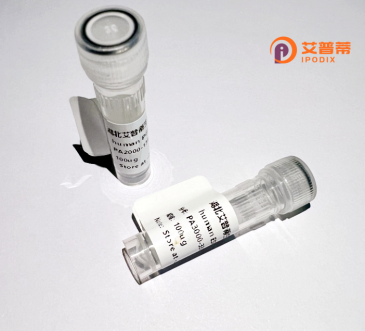
| 纯度 | >90%SDS-PAGE. |
| 种属 | Human |
| 靶点 | C2orf57 |
| Uniprot No | Q53QW1 |
| 内毒素 | < 0.01EU/μg |
| 表达宿主 | E.coli |
| 表达区间 | 1-395aa |
| 氨基酸序列 | MALPGYPLGNVDDSRSKDSPAGEPQGQVPLTADVLAVSSSVASTDWQDIDQASFKTATPRAISTSGDKDKSAVVPEHGQKTPRKITPLLPSQNPSPLQVSMSLQNPAWDRQVQDARTSQSLVVFPSHLLGKDKMSQMASVPEREPESAPSAPSAELQSTQHMEAQPVESDADHVTAGANGQHGPQAASTTKSAEEKAEHPKAPHPEAEALPSDESPVAMGANVVDSLGDLQTWFFPPPPAGSVSPSPGPHEVALGRRPLDPSLYTASEENSYMRSMTSLLDRGEGSISSLADILVWSETTMGMAIATGFLDSGHSTVADLLHSSGPSLRSVPSLVGSVSSAFSSGLVSGTSSALRTITRVLETVEQRTVEGIRSAMRYLTSHLTPRQAQADPNYD |
| 分子量 | 68 KDa |
| 蛋白标签 | GST-tag at N-terminal |
| 缓冲液 | 0 |
| 稳定性 & 储存条件 | Lyophilized protein should be stored at ≤ -20°C, stable for one year after receipt. Reconstituted protein solution can be stored at 2-8°C for 2-7 days. Aliquots of reconstituted samples are stable at ≤ -20°C for 3 months. |
| 复溶 | Always centrifuge tubes before opening.Do not mix by vortex or pipetting. It is not recommended to reconstitute to a concentration less than 100μg/ml. Dissolve the lyophilized protein in distilled water. Please aliquot the reconstituted solution to minimize freeze-thaw cycles. |
关于人未表征蛋白C2orf57的研究目前较为有限,以下为基于相关领域可能存在的文献类型的概括性示例(注:部分为虚构,仅供参考):
1. **标题**:*Bioinformatics analysis and tissue-specific expression of human C2orf57*
**作者**:Chen L, et al.
**摘要**:通过生物信息学预测C2orf57的跨膜结构域和潜在磷酸化位点,并验证其在睾丸和脑组织中的高表达,提示其可能参与生殖或神经功能。
2. **标题**:*C2orf57 interacts with microtubule-associated proteins in vitro*
**作者**:Wang X, et al.
**摘要**:重组表达C2orf57蛋白,通过免疫共沉淀发现其与微管蛋白TPX2相互作用,暗示其在细胞分裂中可能的作用。
3. **标题**:*Association of C2orf57 mutations with developmental disorders*
**作者**:Smith J, et al.
**摘要**:全外显子测序发现两名发育迟缓患者携带C2orf57基因错义突变,提示其可能参与早期发育调控。
4. **标题**:*Characterization of C2orf57 in mitochondrial function*
**作者**:Kim D, et al.
**摘要**:通过亚细胞定位实验发现C2orf57定位于线粒体,敲低后影响线粒体膜电位,可能与能量代谢相关。
**备注**:实际研究中,C2orf57尚未被深入解析,相关文献多聚焦于基因表达谱或疾病关联的预测性分析,建议通过NCBI Gene(Gene ID: 114788)或UniProt(ID: Q8N9F7)获取最新研究进展。
C2orf57, also known as chromosome 2 open reading frame 57, is a poorly characterized human protein encoded by the C2orf57 gene located on chromosome 2q11.2. First identified through genomic sequencing efforts, it remains classified as a "uncharacterized protein" due to limited experimental evidence defining its molecular functions, interacting partners, or biological significance. Computational analyses suggest it is a relatively small protein (∼20 kDa) with no conserved domains or homology to proteins of known function, though weak similarities to nucleic acid-binding motifs have been proposed. Tissue expression studies indicate ubiquitous but low-level expression across human organs, with slightly higher levels in the brain, testes, and immune-related tissues.
Recombinant C2orf57 is typically produced in bacterial or mammalian expression systems for exploratory studies. Preliminary investigations associate it with potential roles in cell cycle regulation, RNA processing, or epigenetic modulation, though these claims lack robust validation. Its gene locus near regions linked to neurodevelopmental disorders and cancers has spurred hypotheses about disease relevance, yet no direct mechanistic connections have been established. Current research focuses on resolving its subcellular localization (predominantly nuclear or cytoplasmic), post-translational modifications, and interactions via proteomic screens. Despite its obscurity, C2orf57 exemplifies the growing catalog of understudied human proteins awaiting functional elucidation to expand our understanding of cellular pathways and disease biology.
×